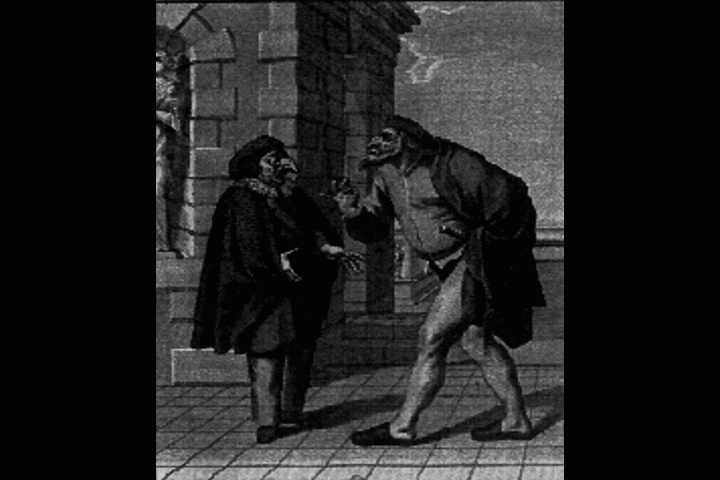ACTOR -- Goals
An actor's goal is to communicate a character to an audience.
This is the only necessary and defining aspect of theatre. All other
artists, including the playwright, serve primarily to aid the actor in
this central goal. At the Renaissance, commedia dell'arte actors improvised an full-length play with every performance, based on a framework of a plot, as in the picture.  Secondary actor's goals are to entertain an audience
and to function as part of an ensemble.
Secondary actor's goals are to entertain an audience
and to function as part of an ensemble.
Audiences judge an actor's performance by several criteria, all of which
are dependent on theatrical and other social conventions. Today,
in most kinds of performances, we say that an actor whose performance we
enjoyed was "believable." This means that his or her actions, movements,
and voice were appropriate to the character, plot, and performance style
of the play. When we consider virtuosity in acting, we tend to think
of actors' abilities to transform themselves, so that they appear substantially
different from role to role.  In some performance styles, virtuosity depends
on other aspects of an actor's performance; for example, a musical
comedy actress such as Carol Channing does not transform herself significantly
from role to role, but she delivers songs and dances that are tremendously
entertaining.
In some performance styles, virtuosity depends
on other aspects of an actor's performance; for example, a musical
comedy actress such as Carol Channing does not transform herself significantly
from role to role, but she delivers songs and dances that are tremendously
entertaining.
The actor's secondary goals are also important. First, an actor's
performance should draw audience members into the theatrical illusion being
presented on stage. The energy projected by the actor begins the
cycle of feedback described in the last section: the live audience
responds to the actor's performance and the actor in turn adjusts his or
her performance in response to the audience. Second, since acting
is usually a group art form, the actor must work within stylistic constraints
established by the playwright and director, and the actor must work effectively
with the other actors in the cast. We often refer to "chemistry"
between actors or a "strong ensemble" when many actors work together effectively.
Tools
An actor's tools are unusual among artists. Whereas a painter's
tools are his watercolors, brushes, and paper, and a pianist's tool
is her instrument, an actor has no tools but him or herself. An actor
uses voice, body, and mind/spirit to create a character. Like
the pianist or other performing artists, the actor is usually an interpretive
artist, meaning that the actor is part of an interpretation of a primary
artist's work -- in this case the primary artist is the playwright.
Because an actor is usually interpreting a role written by someone else,
the play text is also a tool for character creation.
The actor usually begins with an analysis of the play: he searches
for all clues about the character's past life, present actions, relationships
with other characters, and function within the plot. From there he
can begin to create the character. Anything not supplied by the playwright
directly is up to the actor's imagination.
The actor then uses her own body, voice, and mind, adapting aspects
of herself to become the character. The actor may alter her voice
by varying her pitch range, dynamic range, timbre, and tempo or by speaking
with a dialect.
The actor will also use his body in ways specifically chosen to express
his character. He will select gestures, postures, and movement patterns
that may be different from his own. Some of these physical aspects
of the character may be determined by the customs of another historical
time; for example an upper class, male character from the English
Restoration may gesture with a handkerchief or fan for effect, carry a
snuff box, and stand with his legs turned out at a ninety degree angle
and the weight resting slightly into one hip. A woman, like this character played by Ann Bracegirdle, might carry a handkerchief of parasol,
but her posture would be similar to a man's.

The character's mental processes are also important; these include
thoughts, emotions, and psychological traits. Analysis of what a
character says and does in the script of the play will be an important
beginning for an actor in finding her character's "inner life".
To Actor Part 2
Back To Reading
List
BACK TO BLOOD'S COURSE MATERIAL
HOMEPAGE
 In some performance styles, virtuosity depends
on other aspects of an actor's performance; for example, a musical
comedy actress such as Carol Channing does not transform herself significantly
from role to role, but she delivers songs and dances that are tremendously
entertaining.
In some performance styles, virtuosity depends
on other aspects of an actor's performance; for example, a musical
comedy actress such as Carol Channing does not transform herself significantly
from role to role, but she delivers songs and dances that are tremendously
entertaining.
 Secondary actor's goals are to entertain an audience
and to function as part of an ensemble.
Secondary actor's goals are to entertain an audience
and to function as part of an ensemble.
